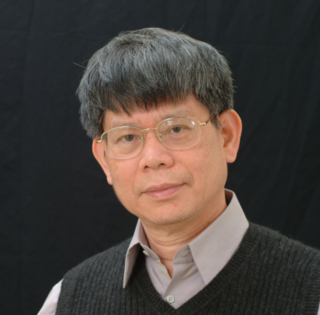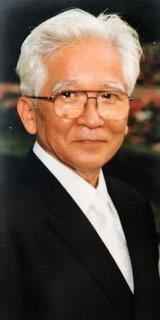
Differential geometry is a mathematical discipline that studies the geometry of smooth shapes and smooth spaces, otherwise known as smooth manifolds. It uses the techniques of differential calculus, integral calculus, linear algebra and multilinear algebra. The field has its origins in the study of spherical geometry as far back as antiquity. It also relates to astronomy, the geodesy of the Earth, and later the study of hyperbolic geometry by Lobachevsky. The simplest examples of smooth spaces are the plane and space curves and surfaces in the three-dimensional Euclidean space, and the study of these shapes formed the basis for development of modern differential geometry during the 18th and 19th centuries.

In geometry, a polyhedron is a three-dimensional shape with flat polygonal faces, straight edges and sharp corners or vertices.

Riemannian geometry is the branch of differential geometry that studies Riemannian manifolds, defined as smooth manifolds with a Riemannian metric. This gives, in particular, local notions of angle, length of curves, surface area and volume. From those, some other global quantities can be derived by integrating local contributions.
In differential geometry, the Gauss map (named after Carl F. Gauss) maps a surface in Euclidean space R3 to the unit sphere S2. Namely, given a surface X lying in R3, the Gauss map is a continuous map N: X → S2 such that N(p) is a unit vector orthogonal to X at p, namely a normal vector to X at p.

In mathematics, solid geometry is the traditional name for the geometry of three-dimensional (3D) Euclidean spaces.

Richard Melvin Schoen is an American mathematician known for his work in differential geometry and geometric analysis. He is best known for the resolution of the Yamabe problem in 1984.

Carl Barnett Allendoerfer was an American mathematician in the mid-twentieth century, known for his work in topology and mathematics education.

In mathematics, an immersion is a differentiable function between differentiable manifolds whose differential pushforward is everywhere injective. Explicitly, f : M → N is an immersion if

In geometry, a flexible polyhedron is a polyhedral surface without any boundary edges, whose shape can be continuously changed while keeping the shapes of all of its faces unchanged. The Cauchy rigidity theorem shows that in dimension 3 such a polyhedron cannot be convex.

In geometry, a Petrie polygon for a regular polytope of n dimensions is a skew polygon in which every n – 1 consecutive sides belongs to one of the facets. The Petrie polygon of a regular polygon is the regular polygon itself; that of a regular polyhedron is a skew polygon such that every two consecutive sides belongs to one of the faces. Petrie polygons are named for mathematician John Flinders Petrie.

Geometry is a branch of mathematics concerned with properties of space such as the distance, shape, size, and relative position of figures. Geometry is, along with arithmetic, one of the oldest branches of mathematics. A mathematician who works in the field of geometry is called a geometer. Until the 19th century, geometry was almost exclusively devoted to Euclidean geometry, which includes the notions of point, line, plane, distance, angle, surface, and curve, as fundamental concepts.

In mathematical study of the differential geometry of curves, the total curvature of an immersed plane curve is the integral of curvature along a curve taken with respect to arc length:
The Alexandrov uniqueness theorem is a rigidity theorem in mathematics, describing three-dimensional convex polyhedra in terms of the distances between points on their surfaces. It implies that convex polyhedra with distinct shapes from each other also have distinct metric spaces of surface distances, and it characterizes the metric spaces that come from the surface distances on polyhedra. It is named after Soviet mathematician Aleksandr Danilovich Aleksandrov, who published it in the 1940s.
Igor Rivin is a Russian-Canadian mathematician, working in various fields of pure and applied mathematics, computer science, and materials science. He was the Regius Professor of Mathematics at the University of St. Andrews from 2015 to 2017, and was the chief research officer at Cryptos Fund until 2019. He is doing research for Edgestream LP, in addition to his academic work.

Gerhard Huisken is a German mathematician whose research concerns differential geometry and partial differential equations. He is known for foundational contributions to the theory of the mean curvature flow, including Huisken's monotonicity formula, which is named after him. With Tom Ilmanen, he proved a version of the Riemannian Penrose inequality, which is a special case of the more general Penrose conjecture in general relativity.

Chen Bang-yen is a Taiwanese mathematician who works mainly on differential geometry and related subjects. He was a University Distinguished Professor of Michigan State University from 1990 to 2012. After 2012 he became University Distinguished professor emeritus.

Tadashi Nagano was a Taiwan-born Japanese mathematician who worked mainly on differential geometry and related subjects.
David Allen Hoffman is an American mathematician whose research concerns differential geometry. He is an adjunct professor at Stanford University. In 1985, together with William Meeks, he proved that Costa's surface was embedded. He is a fellow of the American Mathematical Society since 2018, for "contributions to differential geometry, particularly minimal surface theory, and for pioneering the use of computer graphics as an aid to research." He was awarded the Chauvenet Prize in 1990 for his expository article "The Computer-Aided Discovery of New Embedded Minimal Surfaces". He obtained his Ph.D. from Stanford University in 1971 under the supervision of Robert Osserman.

Mathematical Models: From the Collections of Universities and Museums – Photograph Volume and Commentary is a book on the physical models of concepts in mathematics that were constructed in the 19th century and early 20th century and kept as instructional aids at universities. It credits Gerd Fischer as editor, but its photographs of models are also by Fischer. It was originally published by Vieweg+Teubner Verlag for their bicentennial in 1986, both in German and (separately) in English translation, in each case as a two-volume set with one volume of photographs and a second volume of mathematical commentary. Springer Spektrum reprinted it in a second edition in 2017, as a single dual-language volume.
A Topological Picturebook is a book on mathematical visualization in low-dimensional topology by George K. Francis. It was originally published by Springer in 1987, and reprinted in paperback in 2007. The Basic Library List Committee of the Mathematical Association of America has recommended its inclusion in undergraduate mathematics libraries.















